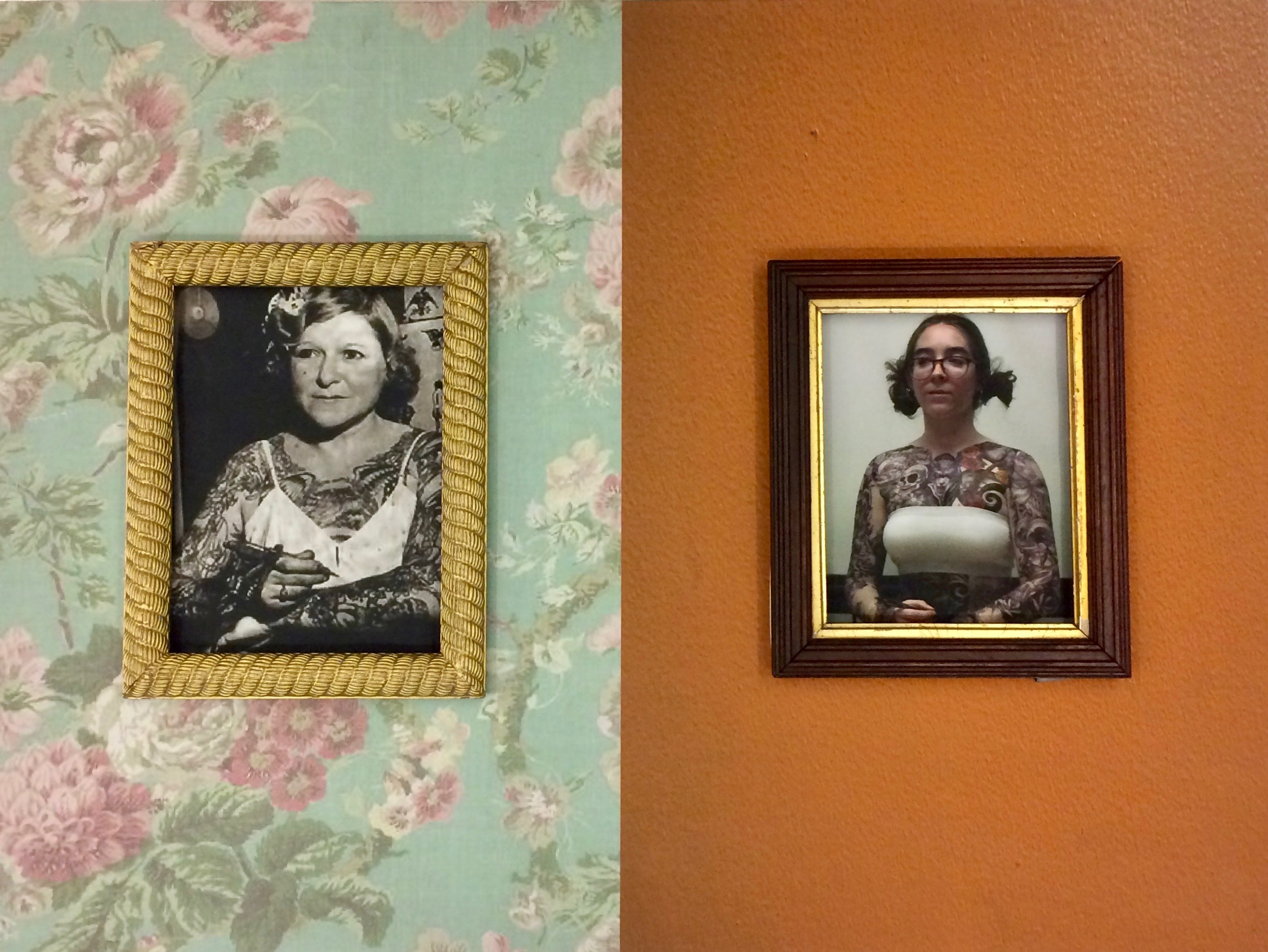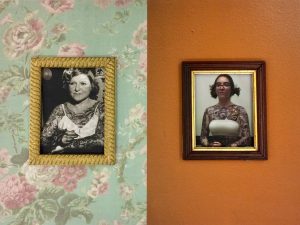Bibliography
Osterud, Amelia. The Tattooed Lady: A History. Speck Press, 2009.
In this book, Osterud described the stories of American women in the 1900s who covered themselves in tattoos. As a living, they performed in front of audiences and captivated them with extravagant stories about their lives and how they received their tattoos. Osterud explored tattoo origins, women’s history, and the circus/entertainment business. In an interview, Ms. Osterud said that tattooing has a varied history because it was practiced by many cultures throughout time. Her interest in doing this research and writing this book was to discover where the negative stereotypes around tattooing originated. She discovered that the stereotypes started with Cesare Lombroso, a “scientist” who published an article about racial profiling. The Savage Art of Tattooing described a study he had conducted that proved that anyone with a tattoo was a criminal and prostitute. However, he only studied criminals and prostitutes but the public and the media didn’t realize that. They jumped onto his ideals and word spread that tattoos were associated with the bad crowd.
Davidson, Deborah. The Tattoo Project: Commemorative Tattoos, Visual Cutlrue, and the Digital Archive. Toronto: Canadian Scholars, 2016.
There are five sections that divide this book. The first part describes the history and culture of tattooing. In the second part of the book, Davidson uses art, poetry, and photos to describe commemorative tattoos. The third section introduces case studies and personal narratives to better understand tattooing. Next, she explains the creation of the digital archive to explore commemorative tattoos and their narratives. In the last section, the author talks about The Tattoo Project. The intention of this book is to provide a description, with visual and poetic components, of the past, present, and future of tattooing. Tattoos can offer insight into specific aspects of a culture and the relationships one has with their community. For example, they have been used for spiritual and decorative purposes, and as part of ceremonies marking social ranking and character.
Untapped cities. “Tattoo History on the Lower East Side in NYC.” Last modified January 15, 2014. https://untappedcities.com/2014/01/15/tattoo-history-on-the-lower-east-side-in-nyc/
This website discussed the history of tattooing in the Bowery. In the beginning, soldiers and sailors were the main customers to tattoo artists in the Bowery however then it spread to women and anyone else who wanted another outlet for self expression. The article talked about the tattooing ban from 1961 to 1997 which was in place because of the many cases of Hepatitis-B. The author then discussed how tattoo artists were housed within barbershops. Not only could a man walk in and get a hair cut and a tattoo, but they could also get abscesses, lice, and teeth removed because barbers were also considered doctors at the time. The author went on to talk about some famous artists from the Bowery. Samuel O’Reilly created the first tattooing machine in 1891. Millie Hull owned her own tattoo shop called the Tattoo Emporium. Charlie Wagner created a new, patented tattoo machine and was the most skilled and sought after tattooist in the Bowery.
Tattoo Archive. “Tattoo History A-Z.” Last modified 2016. https://www.tattooarchive.com/history/hull_mildred.php
“Tattoo History A-Z” is in association with The Paul Rogers Tattoo Research Center and its goal is to preserve tattoo history. This website highlights important people in tattoo history from all different decades some from America, others from all over the world. The website features these artist’s drawings and photographs of them. The authors gathered personal information from many different sources including newspapers from as early as the 1800s. The authors discovered public records of these people’s births and deaths, city directory lists, any lawsuits that they were apart of, any run ins with the law, or patents they received. For example, Samuel O’Reilly and Charlie Wagner created tattooing machines, so the authors checked their patent numbers and looked for any existing machines like the one’s they created. The authors found and described one of the tales Nora Hildebrandt told at her circus job about how she received her tattoos.
Seminar Initial Remarks
Tatooing
I am interested in tattooing and how it has shaped the world of beauty. Over the years, tattoos have served different roles. Tattooed people were attractions to see at American circuses in the 1900s. Around this time is when it developed it’s anti-establishment and gang associations. Now they are chiefly worn for aesthetic appeal. For this project, I want to trace the history of tattooing to form a better argument about how they can hold significance and shouldn’t be associated with certain behaviors or past beliefs. I want to analyze how Mildred Hull has paved the way for female beauty.
Tattooing in todays world:
– job world they are looked down on – worried about what the consumers think
– more about expression
I want to know the history of tattooing so I can understand why it got its bad reputation.
This exhibit would be interesting because it is an art form that is rarely acknowledged in a positive or traditional museum setting. It would be relevant to an audience because it has been around for many years and they are becoming more and more common with young adults.
Does it show class rank?
yes, the lower class
Stages for my studio project
I started this project by developing my idea. I then digitally designed it in Adobe Illustrator and then I preceded to create it.
I used foam board and then I printed out the two backgrounds. I then printed out a photo of Mildred Hull and found two photo frames. I recreated Mildred’s portrait by covering myself in temporary tattoos. I then printed out the photo and framed it. I created this project without any one else’s help so keeping the frames straight and centered while nailing them into the board was difficult. It was also hard pasting the background printouts flat on the board.
Wall Label Including Artist Statement
“Can a Tattooed Woman Have The Same Opportunities?”
Mixed Media
36×48
My art piece compares the story of a tattooed woman from the 1900s to the modern day tattooed woman. Mildred Hull used her tattoos to her advantage in the 30s, while a woman in 2017 would be at a disadvantage in the workplace. Mildred was born in New York around the turn of the century. She went to school until she was thirteen years old but dropped out and got a job at a tattoo parlor. She didn’t making much money there so she covered herself in tattoos and got a job at the local circus for $80 a week as an entertainer. After saving up, she opened her own tattooing shop in the Bowery called Tattoo Emporium. At this time she was the only well known woman tattooists in the Bowery. She took risks, used her tattoos to her advantage, and became a respected business woman.
For this project I wanted to visually compare my life with hers. I designed what I imagine a hallway in Mildred’s 1930s house looked like and then I made a more modern design of what a hallway in my house looks like. I then put the two next to each other. In my family, as each of my siblings and I graduated high school, we got our portraits hung on the wall in our house. It was an honor and a sign that our parents were proud of us. For this piece I hung a portrait of tattooed Mildred and a portrait of tattooed me. As I was researching Mildred I developed respect for her. That got me thinking. Would my parents respect me if I were tattooed like Mildred? Would my photo get taken down from the wall if I disobeyed them after they strictly told me not to get any tattoos? Why do my parents not like tattoos in the first place? Would Mildred’s parents have disowned her if they found out what she did to her body, or would they still love and support her because she had become a successful business woman? This piece is supposed to get the viewer thinking about the difference between me and Mildred. What would the viewer think of us? Would we be rejected or would our tattoos be overlooked?
In most situations, our tattoos would not be overlooked. In America, tattoos have always had a bad reputation, being associated with gangs, violence, and criminal acts. Unfortunately a woman is lucky to acquire a job in the business world if she even has one visible tattoo. Tattooing was never a respected art after America was taken over by the British. In any other culture, including American Indian, tattooing is a sign of power, respect, appreciation, and can reflect a person’s life story. However here, tattoos are a sin. Is it simply because others don’t think tattoos are beautiful or is it that they don’t want others to be able to physically differentiate themselves with this art? If someone opposes tattoos, then don’t they oppose self expression too? Whatever it is, these negative associations towards tattoos shouldn’t exist. Mildred and anyone else who has a tattoo suffers with this discrimination. They are looked at differently by everyone. A lot of people get scared or worried when they see someone with a tattoo because they think it represents anti-government and establishment beliefs. Opposition towards tattoos is discrimination against individuality and self expression, and that itself should be a sin.
Reflection
I enjoyed this project and I am pleased with my final timeline and art piece. I liked how in-depth this project was. It required a lot of research and idea development, and it concluded with a presentation of our work to the class and special guests. Initially I didn’t know much about tattoo history or that it had a strong presence in Lower Manhattan in the 1900s. It was fascinating learning about the culture that tattooing in New York started in. I enjoyed the opportunity to learn about tattooing’s past and how it developed its negative associations and I liked being able to compare one woman’s story from the 1900s to the current day standards of body art. It did change my views on tattooing though. For a while I wanted to get a few tattoos however after covering myself in them I realized that our bodies are beautiful as they are. Even if I loved all the tattoos I had and they all had meanings to me, I still wouldn’t want to be covered head to toe in them. I’m not saying tattoos aren’t beautiful, I am all for self expression, however I just personally realized that’s not for me.




Very interesting
You educated me in the history of tattoos
I remember the problems associated with hepatitis.
Regulations and supervision has helped
Loved your ending!!!
Our bodies are too beautiful to cover them with ink!